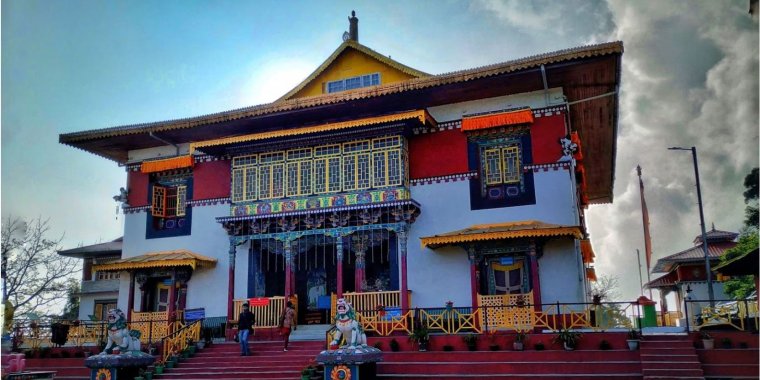Pemayangtse Monastery: A Spiritual Jewel in Sikkim

Strong 8k brings an ultra-HD IPTV experience to your living room and your pocket.
Settled in the serene hills of Pelling in West Sikkim, Pemayangtse Monastery is one of the most prominent and revered Buddhist monasteries in the region. Known for its profound spiritual significance, stunning architecture, and breathtaking panoramic views of the surrounding mountains, Pemayangtse is a must-visit destination for those exploring the rich cultural and spiritual heritage of Sikkim.
Pemayangtse Monastery Pelling: A Historical Overview
Located approximately 2 kilometers from Pelling, Pemayangtse Monastery stands as a symbol of Tibetan Buddhist culture in Sikkim. The monastery was founded in the early 18th century by Lama Lhatsun Chempo, and it belongs to the Nyingma sect of Tibetan Buddhism. Over the years, it has become a key center for Buddhist learning, meditation, and religious practices in the region. Its name, "Pemayangtse," translates to “Perfect Sublime Lotus,” symbolizing purity and enlightenment.
The monastery is not only an important religious center but also a hub for visitors seeking to connect with the spiritual atmosphere of Sikkim. The architecture of the monastery is a fine example of Tibetan Buddhist design, with vibrant murals, intricate carvings, and beautifully crafted prayer wheels.
Pemayangtse Monastery Sikkim: Spiritual Significance and Architecture
The spiritual importance of Pemayangtse Monastery cannot be overstated. It is the oldest and one of the most prominent monasteries in West Sikkim. Over the centuries, the monastery has become a place of pilgrimage for Buddhists, attracting travelers from all over the world who come to pay their respects, meditate, and explore the teachings of Buddhism.
One of the standout features of Pemayangtse Monastery is its magnificent architecture. The monastery’s main structure is a multi-tiered building, with a large prayer hall and an ornate altar. The walls are adorned with intricate paintings depicting the life and teachings of Buddha, as well as scenes from Tibetan Buddhist mythology. The central altar is dominated by a stunning statue of the Buddha, which is an important focal point for visitors.
Another remarkable feature of the monastery is its three-dimensional model of the heavenly abode of Guru Rinpoche, which was created by the monks of Pemayangtse. This stunning sculpture represents the Mandala of Guru Rinpoche, also known as Padmasambhava, the founder of Tibetan Buddhism. It is housed in a small room in the monastery and is a sacred piece of art that attracts many visitors.
The monastery’s peaceful surroundings, combined with its historical and spiritual significance, make it an ideal place for meditation and reflection. The panoramic views of the majestic Kanchenjunga Range, which can be seen from the monastery, add to the sense of tranquility and awe that envelops the site.
Pemayangtse Monastery Images: A Feast for the Eyes
The visual beauty of Pemayangtse Monastery is one of its main attractions. The monastery is perched on a hilltop, providing stunning views of the surrounding landscapes, including the snow-capped peaks of Kanchenjunga and the lush valleys below. The monastery’s architectural details, including the vibrant murals, ornate prayer flags, and intricate woodwork, offer ample opportunities for photographers to capture the essence of Tibetan Buddhist art and culture.
Visitors will find themselves awestruck by the monastery’s serene ambiance and the magnificent beauty of the surrounding nature. The combination of rich history, intricate design, and the breathtaking scenery around Pemayangtse make it a photographer’s paradise. Whether you’re capturing the quiet moments of prayer, the stunning vistas, or the religious artwork inside, the images taken here will forever be a reminder of this spiritual retreat.
Pemayangtse Monastery Entry Fees: Practical Information
While Pemayangtse Monastery is open to all visitors, there is a small entry fee for tourists. The fee is relatively affordable, ensuring that the monastery remains accessible to everyone, while also helping to maintain the site’s upkeep and preservation.
As of the latest information, the entry fee is typically around INR 30 to INR 50 for Indian nationals. Foreign nationals might be charged a slightly higher fee, usually around INR 100. However, fees may vary depending on the time of year or specific events, so it’s always a good idea to check with local sources or tour operators for the most up-to-date information.
In addition to the entry fee, there may be separate charges for photography inside the monastery or for guided tours. While not mandatory, guided tours are highly recommended for those interested in learning more about the monastery’s history, significance, and the Buddhist practices followed here.
Best Time to Visit Pemayangtse Monastery
The best time to visit Pemayangtse Monastery is during the spring (March to May) and autumn (September to November) months, when the weather is mild, and the skies are clear. This period also offers stunning views of the Kanchenjunga Range and the surrounding mountains. The monsoon season (June to August) may bring heavy rainfall, making travel to the monastery a bit challenging. Winter (December to February) can be cold, but the sight of snow-capped peaks adds a unique charm to the monastery’s surroundings.
Nearby Attractions Around Pemayangtse Monastery
Visiting Pemayangtse Monastery offers an opportunity to explore the nearby attractions in Pelling and West Sikkim:
Rabdentse Ruins: Located nearby, Rabdentse was the ancient capital of Sikkim. The ruins offer a glimpse into the rich history of the region and provide amazing views of the surrounding landscapes.
Kanchenjunga Falls: A stunning waterfall located a short distance from Pelling, offering an excellent spot for nature lovers and photographers.
Sangachoeling Monastery: Another important Buddhist monastery located in the region, offering a peaceful atmosphere for meditation.
Khecheopalri Lake: A sacred lake revered by locals, Khecheopalri is known for its spiritual significance and serene beauty.
Why Visit Pemayangtse Monastery?
There are several reasons why Pemayangtse Monastery is a must-visit site for those traveling to Sikkim:
Spiritual Significance: It is a center of Tibetan Buddhism, where visitors can learn about Buddhist practices, teachings, and philosophy.
Architectural Beauty: The monastery’s unique Tibetan-style architecture, with its vibrant murals, intricate carvings, and grand statue of Buddha, is a feast for the eyes.
Scenic Views: The monastery offers stunning panoramic views of the Kanchenjunga Range and the surrounding mountains, making it a perfect destination for nature lovers and photographers.
Tranquil Atmosphere: The peaceful surroundings make it an ideal place for meditation, relaxation, and connecting with your spiritual self.
In conclusion, Pemayangtse Monastery is not only a place of religious significance but also a scenic and peaceful retreat, offering a unique cultural experience for visitors. Whether you are a spiritual seeker, a history enthusiast, or a nature lover, the monastery is sure to leave you with unforgettable memories of its beauty and serenity.
Note: IndiBlogHub features both user-submitted and editorial content. We do not verify third-party contributions. Read our Disclaimer and Privacy Policyfor details.


